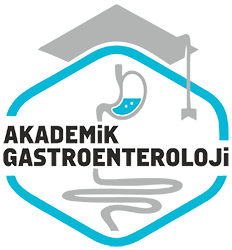Nisan 2008
Inflamatuvar barsak hastalığında histopatolojik kriterlerin klinik semptomatolojiyle ilişkisi
Correlation of histopathological criteria with clinical presentation in Inflammatory Bowel Disease
- Ana Sayfa
- Sayılar
- Nisan 2008
- Inflamatuvar barsak hastalığında histopatolojik kriterlerin klinik semptomatolojiyle ilişkisi...
Özet
Ülseratif Kolit ve Crohn hastalığınin ayirici tanısında histolojik parametreler ve kolit paterni önemlidir. Bu çalışmada histolojik parametrelerin ve kolit paternlerinin ülseratif kolit, Crohn hastalığınin ayirimindaki değerini ve histopatolojik bulgularin klinik semptomlarla olan korelasyonunun belirlemesi amaçlanmıştır. Inflamatuvar barsak hastalığı tanıli 70 olgu çalışmaya alinmıştır. Histopatolojik kriterler içinde En sık olarak lamina propria inflamasyonu (n:66; %94,3), kript distorsiyonu (n=62; %88,6), kriptit ve mukus kaybi (n=58; 82,9%) izlenmıştır. Lamina propria inflamasyonunun ülseratif kolit’de Crohn hastalığına göre istatistiksel olarak anlamli artis gösterdigi tespit edilmıştır (p<0,05). Diskida kanaması olan olgularda kriptitin ve bazal lenfoplazmositozun anlamli olarak artis gösterdigi (p<0,05), karın ağrısı ve siskinlik şikayeti ile kriptit ve kript absesi gelisiminin artis gösterdigi (p<0.05), kendini iyi hisseden olgularda ise kript absesinin anlamli olarak daha az görüldügü tespit edilmıştır (p<0.001). sonuçlarımiz inflamatuvar barsak hastalığı’nda saptanan histolojik degisıklıklerin uygun klinik, endoskopik bulgulari içeren kategoriler altında değerlendirilmesi ile tanısal ve tedavi yaklasimin daha sağlıklı olabilecegini ortaya koymustur.
Abstract
In order to overcome the difficulty in the diagnosis of Inflammatory bowel disease it might be useful to assess the value of histologic parameters and colitis pattern in distinguishing ulcerative colitis from Crohn’s disease. We aimed to assess the correlation of clinical and histologic parameters in distinguishing ulcerative colitis from Crohn’s disease. A total of 70 Inflammatory bowel disease patients were included in the study. The most commonly observed histologic finding was lamina propria inflammation (n:66; 94,3%) and crypt distortion (n=62; 88.6%), followed by cryptitis and mucus depletion (n=58; 82.9%). No statistical difference was observed between ulcerative colitis and Crohn’s disease patients in terms of histologic parameters except lamina propria inflammation (p<0.05) which was more common in ulcerative colitis. Patients who had rectal bleeding showed significantly increased cryptitis, basal lymphoplasmacytosis (p<0.05). In patients with abdominal pain (p<0.05) and tenderness (p<0.05), cryptitis and crypt abscesses were significantly increased. Crypt abscesses were significantly (p<0.05) less common in patients who had the sense of well being. Our results suggest that histological changes in Inflammatory bowel disease may be grouped under clinically relevant categories that provide a framework for their interpretation and could be used to design appropriate therapy.



